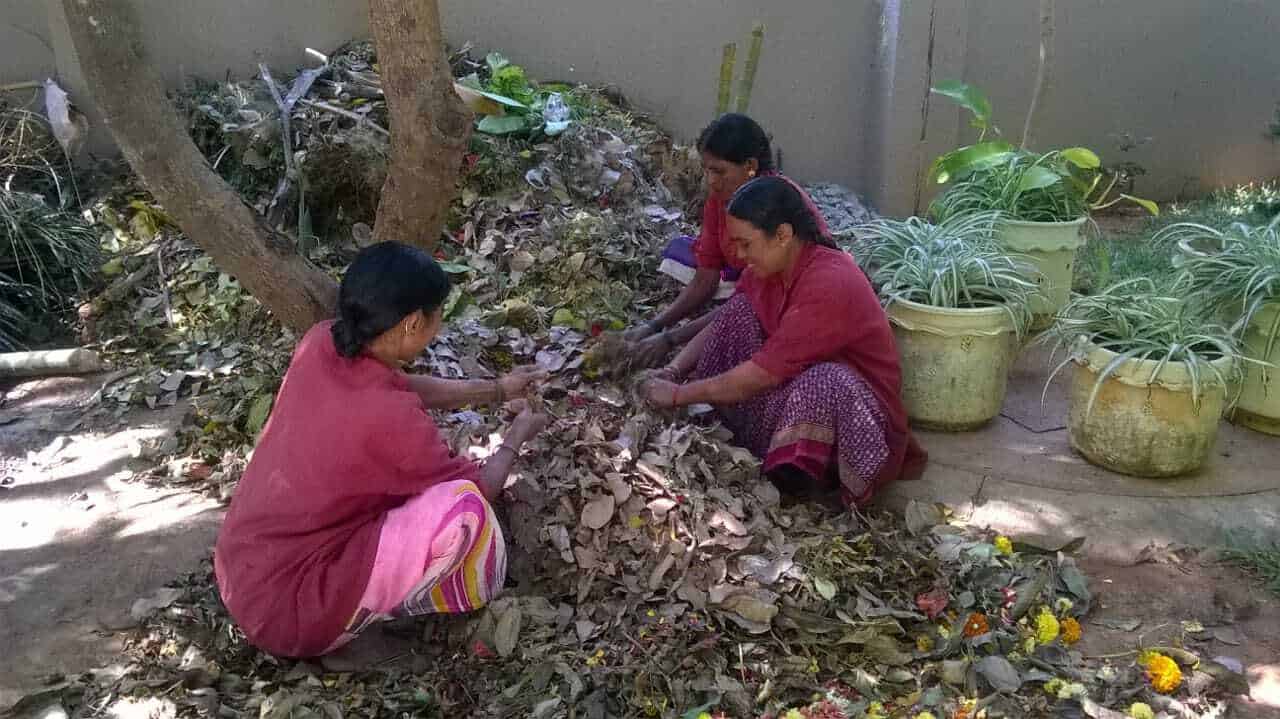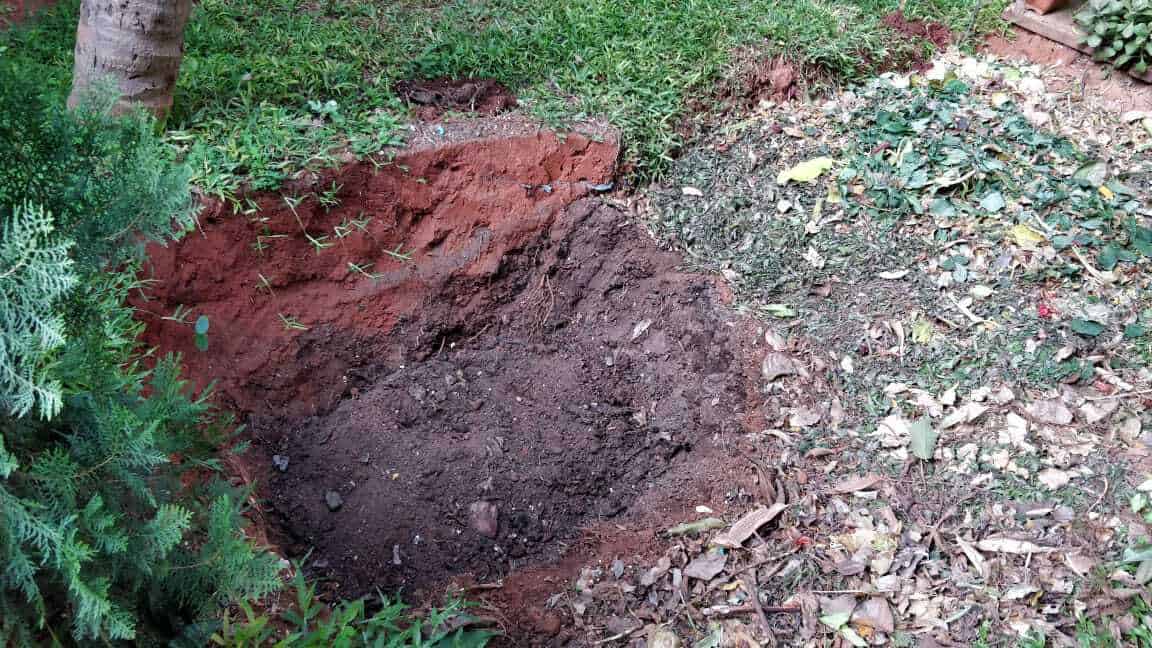In Part 1 of this series, I wrote about how we, at Sobha Quartz apartment in Bellandur, have been composting garden waste. Our compost pits are not just an ideal way to dispose of garden waste, they also yield high-quality manure for the entire garden. Our apartment association also saves around Rs 25,000 annually with this process, as we don’t have to ship out the waste or buy chemical fertilisers for the garden anymore.
But how exactly does composting happen? And how can you ensure good-quality compost? This part of the series deals with these questions.
What exactly is ‘composting’?
Composting is a process by which organic materials that are regarded as waste, are recycled to produce useful soil conditioner. The organic matter deposited in the compost pit naturally gets decomposed or oxidised to produce humus/compost. This process is aerobic, that is, it requires the presence of oxygen or air.
Effective composting has three components:
- Human management
- Internal biological heat in the compost material
- Aerobic conditions, that is, adequate oxygen supply
Who does the work of composting?
When garden waste is deposited in a pit, covered and then maintained warm and wet, as explained in Part 1, worms and microbes from the surrounding soil quickly migrate into it and start consuming the waste, starting the decomposing process. There are many types of microorganisms found in active compost.
Prominent among them are:
- Bacteria: Most commonly, mesophilic and thermophilic bacteria. Mesophilic bacteria are the bacteria that grow best in moderate temperatures, typically between 20 and 45 °C. In contrast, thermophilic bacteria thrive at relatively high temperatures, between 50 and 70 °C. They get into action during different phases of the composting process.
- Actinobacteria: Bacteria necessary for breaking down tree bark and the like.
- Fungi: Molds and yeast help break down materials that bacteria cannot, especially lignin in woody material.
- Protozoa: These single-celled microscopic organisms consume bacteria, fungi and microorganic particulates, thus keeping the bacterial population in check.
- Rotifers: These help control the populations of both bacteria and small protozoans.
- Earthworms: They consume partly-decomposed organic material. Their excreta add nutrition and value to compost.
What organic materials to use, in what ratios?
The composting microbes need four ingredients to multiply and work effectively:
- Carbon (C): The carbon in dry leaves is oxidised by microbes to produce heat, which is essential for composting
- Nitrogen (N): The nitrogen in leaves help microbes grow and reproduce
- Oxygen (O): Essential for oxidising the carbon in leaves
- Water: In right amounts, it maintains aerobic activity
When present in certain ratios, these ingredients facilitate microorganisms working at a rate that would heat up the material in reasonable time. The most efficient composting occurs at the C:N ratio of about 25:1. When the C:N ratio is about 30:1 or less, the composting process is rapid.
After digging the compost pit, all you need to do is:
|
But if the ratio is above 30:1, the substrate is nitrogen-starved. Conversely, if the ratio is too low – say below 15:1 – some nitrogen would leave the system as ammonia. The composting process would be slowed down too.
So, how do you ensure the right C:N ratio?
Nearly all plant and animal matter have both carbon and nitrogen, but the ratios vary widely. Dry, browning leaves contain more carbon, while green leaves contain more nitrogen. So, for example, dry autumn leaves contain carbon and nitrogen in the ratio of about 50:1, depending on the tree species. Whereas the ratio in fresh grass clippings is about 15:1.
Few situations offer the ideal mix of materials. But by observing the quantities of materials deposited in the pit over time, you can easily track the carbon and nitrogen contents in it.
While this is the theory, my experience in Bengaluru is that you need not strive hard to ascertain the C:N ratio. As you keep dropping green, yellow and brown leaves day after day in the pits, those dropped earlier keep drying there. Hence the contents ultimately tend to reach the requisite ratio.

Housekeeping staff at Sobha Quartz ensuring there isn’t plastic waste among the leaves to be composted. Pic credit: Luke Dhanaraj
So, all you have to ensure is that the mix is largely made up of green leaves, as well as some dry/browning leaves! Also, given the relatively high ambient temperatures in Bengaluru these days, the process gets accelerated by itself.
How to maintain adequate oxygen and water levels?
Apart from the C:N ratio, oxygen and water balance is also critical in maintaining the desired temperature of 50-70 °C at the most active phase of decomposition. Earthworms naturally help increase oxygen levels in the pit. They not only ingest partly decomposed material and add their nutritious excreta to it, but also continually re-create aeration and drainage tunnels while moving through the composting material.
The material also needs moisture content of 40 to 60 percent, to facilitate multiplication of beneficial microbes. By watering the pit every 2-4 days, you would be able to maintain the requisite oxygen/water ratio.
With all requisite ingredients – carbon, nitrogen, oxygen and water – maintained in proper balance, microorganisms would be able to break down the organic matter to produce compost.
The three phases of composting
Under ideal conditions, composting proceeds through:
- The initial, mesophilic phase: Mesophilic microorganisms carry out decomposition under moderate temperatures.
- The second, thermophilic phase: As the temperature rises, various thermophilic bacteria decompose the material. This is the most active phase of decomposition.
- Maturation phase: As the supply of high-energy, carbon-based compounds dwindle in the pile, the temperature starts declining, and the mesophiles predominate again. By the end of this process, in around three months, composting is complete!

Compost in the pit that’s being used as manure. Pic credit: Luke Dhanaraj
Overall, pit composting is one of the easiest ways to deal with garden waste. All you need to do is maintain the right mix of organic material and water the pit regularly.
Very good write up. Am sure more apartments will take to composting their garden waste using tips given here.
Ncof waste decomposer, decompose the organic waste very fast in 3 week. It cist about 20 rupees plus molasses. Please see nco
Nice effort ,we would like to replicate this in our apartment , have similar business case